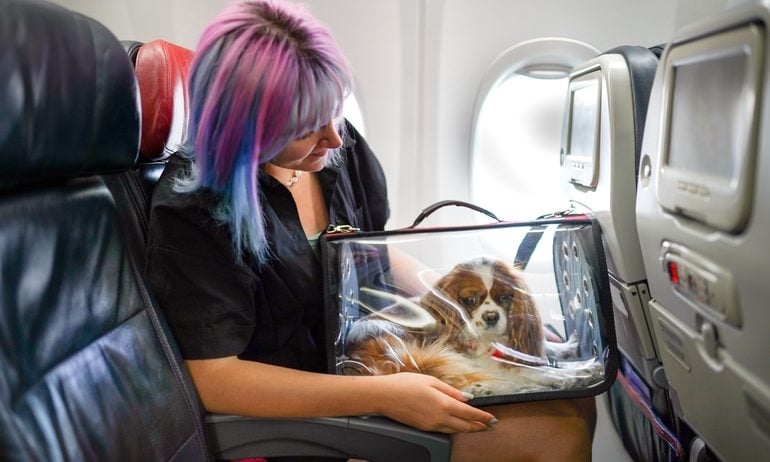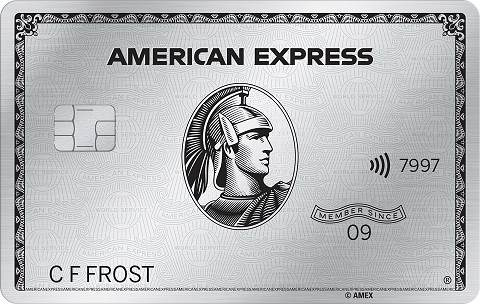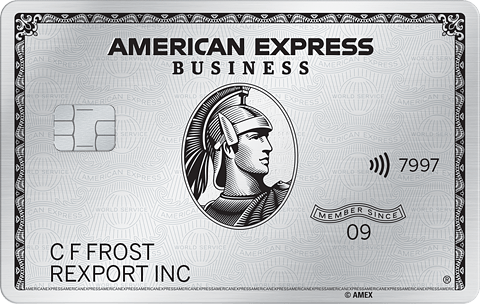How to Fly With a Dog
Flying with dogs takes more pre-planning than you might think.

Many or all of the products on this page are from partners who compensate us when you click to or take an action on their website, but this does not influence our evaluations or ratings. Our opinions are our own.
Table of Contents
If you want to take your dog on a plane, you’ll need to do some planning to ensure you and Fido have a smooth flight. First, you’ll want to figure out if your dog is eligible to travel at all based on their size and breed. There is also usually a pet fee and you will most likely have to fill out extra paperwork, which can vary from airline to airline.
The best advice is to talk to your veterinarian and your airline about what you need to do. You’ll want to familiarize yourself with the airline’s pet policy and figure out if there are any restrictions in the destination you’re traveling to.
Flying with a large dog vs. small dog
Flying with a large dog is a vastly different experience than flying with a small dog. When you travel with a small dog, you’re able to take your pet into the cabin with you and keep them in a pet carrier next to your feet.
A large dog, on the other hand, will need to travel in the cargo hold. On some planes, this area is temperature controlled, but on others, it is not. You will not be able to be with your dog for the duration of the flight.
Airlines also charge different prices for dogs traveling in cabin and cargo.
Flying with a dog in cabin vs. cargo
In-cabin
Generally, if your dog in its carrier can fit under the seat in front of you, it can go in the cabin. So that means a dog weighing up to about 20 pounds. Of course, that under-seat space can vary depending on the aircraft, and airlines typically restrict how many total pets are allowed per flight — which is why you should check with the airline. You can’t buy an extra seat for your dog unless you're flying JSX or JetBlue Airways.
Generally speaking, traveling with a dog as a "carry-on luggage" item usually incurs a lower fee than if it travels in the belly of the plane as cargo. And by the way, a pet in its carrier counts as your carry-on bag.
Having your dog with you might provide peace of mind — although you’re technically not allowed to take it out of the carrier during the flight.
» Learn more: What it costs to fly with your pet in the plane cabin
As cargo
The other option — and the only option for bigger dogs — is flying as cargo in a pressurized, temperature-controlled compartment not too different from the passenger cabin. These dogs essentially fly as checked bags on the same flight as you or unaccompanied, as shipping cargo, sometimes called manifest cargo or air freight.
The Humane Society of the United States generally advises against flying your dog as cargo, but this is the only option for bigger dogs. Also not all airlines will transport dogs as cargo. Southwest Airlines and JetBlue Airways, for example, offer only in-cabin flights for small dogs and cats.
Whether you choose cabin or cargo, you must adhere to airline rules about your dog’s age and weight. For example, United Airlines requires puppies be at least 2 pounds or 10 weeks old.
Using a dedicated pet shipping company is another way to go. You can find one at International Pet and Animal Transportation Association, an industry organization.
How much does it cost to fly with a dog?
Owning jet-setting pets isn't cheap. First, you’ll have to make a reservation for your dog.
American Airlines, Southwest and JetBlue charge $125 each way for an in-cabin pet, though fees are somewhat less on other airlines, like Frontier ($99) and Delta ($95). The fee is usually payable when you get to the airport, not when you book.
Potential related cost: Because your in-cabin pet counts as your carry-on, you might be paying to check your roll-aboard unless you get a free checked bag because it’s a perk of your frequent flyer elite status or your airline-branded credit card.
Pets that fly as cargo often cost more and there might be restrictions on the animal’s size, weight, age and destination. Some airlines do not disclose the price on their website and you will only see the price at the time of booking. Alternatively, you may need to call to find out the cost of bringing your pet in cargo. If you have a layover of more than a few hours, it could trigger another pet fee.
There aren't any popular travel credit cards that include specific benefits for flying with pets, but several offer airline incidental credits that can be put towards any fees charged for pet travel.
$695.
$695.
$550
$95.
Up to $200 annually with your preferred airline. Enrollment required. Terms apply.*
Up to $200 annually with your preferred airline. Enrollment required. Terms apply.
Up to $250 annually with your preferred airline. Enrollment required. Terms apply.
Up to $100 annually.
Additional expenses could include the cost of a preflight veterinary visit and pet carrier. Some experts say it’s a good idea to have an identification microchip implanted in your pet in case it gets lost.
» Learn more: How to make traveling with your pet affordable
In our most recent analysis on flying with pets, we ranked the major U.S. airlines on various factors including fees, types of animals allowed, whether you can bring pets in cargo and number of pets allowed per passenger, among other facrtors.
Here's how they stacked up:
» Learn more: The best travel credit cards for pet owners
Weight limit for dogs on planes
How much does a dog have to weigh to fly? It varies by airline and whether your dog will fly in the cabin with you or in cargo. In addition, some airlines also have limits on the size of the pet carrier.
For example, if you bring a pet as checked baggage (in cargo) on Hawaiian Airlines, the pet and kennel combined weight cannot exceed 70 lbs. If you’re bringing your furry friend with you in the cabin, it must fit comfortably in its carrier under the seat in front of you. Generally though, the weight limit is much lower if your pet is riding in the cabin with you.
Is it safe for dogs to fly?
Check with your veterinarian to make sure your dog is healthy enough for air travel. Some species, especially pug-nosed dogs such as boxers and Boston terriers, aren’t allowed to fly on many airlines because it can be hard for them to breathe at high altitudes.
You may also need a health certificate from a veterinarian seven to 10 days before you fly, according to airline industry group Airlines for America.
Aside from health and breed, make sure you're aware of other potential rules, restrictions and guidelines. Visit your airline's website to find out more about your specific trip.
Consider the kennel
Airlines can have lengthy and detailed requirements for the box your dog rides in, often called a crate, carrier or kennel. Generally, the kennel will need to be large enough for your dog to stand up and turn around inside. Airlines have maximum size requirements. For example, American Airlines allows an in-cabin carrier kennel of up to 19 inches in length, 13 inches in width and 9 inches in height if it's noncollapsible, larger if it’s collapsible.
Airlines and animal experts say to reduce stress, it’s important to acclimate your dog to the kennel before flying.
Here are kennel tips from Airlines for America — these are especially important if your dog travels as cargo:
Label your dog’s kennel with your contact information.
Write “LIVE ANIMAL” on the top and one side of the kennel. Draw arrows or write “THIS SIDE UP” on two sides of the kennel.
Put bedding or “absorbent material” on the kennel floor.
Attach empty food and water dishes to the inside of the kennel. Ensure they can be accessed from the outside.
Challenges of international flights
Requirements for flying internationally with your dog are more complex and typically require even more planning. And some airlines — Southwest is an example — won't allow pets on international flights at all.
If pets are allowed, you’ll need to obtain an international health certificate and comply with the requirements of your destination country. The U.S. Department of Agriculture’s Animal and Plant Health Inspection Service lists regulations by country.
Upon return to the U.S., dogs may need proof of immunization against rabies, according to the Centers for Disease Control and Prevention.
United, for example, suggests for international trips that you contact the appropriate embassy or consulate at least one month before your trip to check on the specifics of the country's entry procedures.
Emotional support animals on planes
If you consider your dog an emotional support animal, don't expect any special treatment — and expect to still pay applicable pet fees. A 2021 policy update from the U.S. Department of Transportation stated that emotional support animals are no longer considered service animals, and airlines aren't required to treat them as such.
That means if your dog is an emotional support animal and was previously allowed on airplanes, there's no guarantee it will still fly for free (and it likely won't fly for free). No major U.S. airlines currently recognizes emotional support animals as service animals and now charge pet fees, which can range from $95-$125 or more one-way.

» Learn more: Traveling with a service dog: what to know
Tips for traveling with a dog
Here are our tips for making flying with Fido a smoother experience, from start to finish.
When booking:
Book a nonstop flight if possible. (That’s different from a “direct” flight, which can have stops.) "This will decrease the chances that your pet is left on the tarmac during extreme weather conditions or mishandled by baggage personnel during a layover," according to the website for the American Society for the Prevention of Cruelty to Animals.
If you must have a layover, some airlines require a minimum layover time when traveling with pets. For example, it might be one hour for domestic flights and two hours for flights outside the continental U.S. The ASPCA recommends you tape a small bag of food outside the kennel so airline workers can feed your dog during these stops.
Try to avoid flying during holidays, which can be busy. In warm weather, try to fly during the morning or evening. In cold weather, midday flights may be better, suggests the American Veterinary Medical Association.
Leading up to travel:
Animal experts generally frown on sedating an animal, and it may not fly with the airline, either. United Airlines, for example, “will not knowingly accept a dog or cat that has been sedated."
The evening before your departure, freeze a dish of water for your dog. That will prevent it from spilling during the loading process, and when it eventually melts, your dog can drink it, advises the ASPCA.
Attach a current photo of your dog to the top of the kennel to help identify it if it escapes the carrier.
Don’t feed your pet in the hours leading up to flight departure because "a full stomach can cause discomfort for a traveling pet," United Airlines' website says. It recommends that you avoid feeding a healthy, large-breed adult dog within four hours of takeoff. "Small-breed puppies younger than 16 weeks and less than 10 pounds may be fed a small meal two to three hours before their flight," the site says.
When checking in:
On the day of flying, arrive at the airport early and check in at the ticket counter with your dog if it’s flying in the cabin. If it’s flying as cargo, check with your airline about where to drop your pet. You might bring it to the passenger terminal if it's traveling as checked luggage or the air cargo terminal, which is usually a different location at the airport. (You might pick up your dog at a cargo terminal, too.
During security screening:
For in-cabin transport of dogs, the kennel goes on the conveyor belt and through the X-ray machine, while you leash your dog and carry or lead it through the metal detector. This can be a hassle, less so if you have membership in TSA PreCheck, which gives you access to quicker lines and means you don’t have to take off your shoes or light jacket.
And remember: Details of airline pet policies vary widely, so it’s best to check directly with the carrier when you’re planning a trip. With a little planning and research, both you and your pet can expect a smooth flight.
Where to find an airline pet policy
Details of pet policies vary widely by airline, so it’s best to check directly with the carrier when you’re planning a trip. Here are links to pet policies of large U.S. airlines:
More resources on how to travel with a dog
Beyond NerdWallet's tips for finding pet-friendly flights and lodging, you can consult the following organizations for more information about flying with your dog:
Kennel fact sheet, International Air Transport Association.
Bringing a dog into the United States, Centers for Disease Control and Prevention.
Travel safety tips, ASPCA.
Flying with pets, Federal Aviation Administration.
Plane talk: Traveling with animals, U.S. Department of Transportation.
Pet travel, U.S. Department of Agriculture.
Traveling with your pet FAQ, American Veterinary Medical Association.
Travel safely with your pet, The Humane Society of the United States.
*More from American Express
American Express relies on airlines to submit the correct information on airline transactions to identify incidental fee purchases. If you do not see a credit for a qualifying incidental purchase on your eligible Card after 8 weeks, simply call the number on the back of your Card. Qualifying airlines are subject to change. See terms & conditions for more details
How to maximize your rewards
You want a travel credit card that prioritizes what’s important to you. Here are some of the best travel credit cards of 2025:
Flexibility, point transfers and a large bonus: Chase Sapphire Preferred® Card
No annual fee: Wells Fargo Autograph® Card
Flat-rate travel rewards: Capital One Venture Rewards Credit Card
Bonus travel rewards and high-end perks: Chase Sapphire Reserve®
Luxury perks: The Platinum Card® from American Express
Business travelers: Ink Business Preferred® Credit Card











